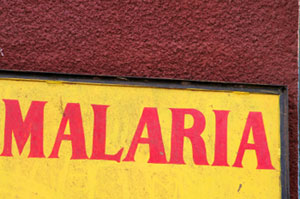Tiny Mosquito
The Buzz on Malaria Symptoms
Malaria symptoms, such as headache, joint pain, fever, sweating, nausea and vomiting, can appear flu-like in nature and can easily be overlooked, but failure to diagnose and treat malaria can lead to coma and possible death. Other common symptoms of malaria include back pain, chills, dry cough, enlarged spleen, impaired function of the brain or spinal cord, seizures and loss of consciousness.
The plasmodium parasite
Malaria is caused by the plasmodium parasite
and can only be transmitted by the female mosquito.
There are four main types of malaria that can
affect humans and there exists certain malaria
symptoms specific to each type.
 Plasmodium
falciparum
Plasmodium
falciparum
The most severe kind of malaria is plasmodium falciparum. It can take
between 7 to 14 days for the symptoms to appear. At the onset, the symptoms
are flu-like; however, if they remain untreated, they will worsen dramatically
and may have a fatal outcome. This type of malaria most commonly occurs
in pregnant women, infants, and travelers to high-risk areas.
Plasmodium vivax, ovale, malariae
Death from these three types of malaria is very
rare; however, proper diagnosis and early treatment
is strongly recommended.
- The plasmodium vivax symptoms can take approximately 12 to 18 days to appear. This type of malaria is known to sometimes relapse after treatment, but can also stay dormant for long periods of time.
- Malaria symptoms caused by the plasmodium ovale strain have a much more gradual onset. Relapse is also possible, but much less common than with plasmodium vivax.
- The symptoms of plasmodium malariae can take up to 40 days to appear and are said to be less severe, but can recur after many years of dormancy.
Malaria in Adults
The first malaria symptoms for plasmodium vivax,
ovale and malariae appear as typical flu-like
symptoms in adults. The sufferer may feel weak,
dizzy and experience vomiting or diarrhea. If
the individual has contracted plasmodium falciparum,
the symptoms will be more threatening in nature.
They can include intense muscle spasms, kidney
failure, low urine output (less than 400 ml
per day), fluid in the lungs, labored breathing,
and frothy sputum.
Malaria in Children
Malaria symptoms can vary in adults and children. Children can exhibit
a cough, rapid and shallow breathing, and/or feverish convulsions. If
they have contracted plasmodium falciparum, they may experience fever,
vomiting, and diarrhea. If the illness remains untreated, the symptoms
can worsen and the child could experience respiratory distress causing
flared nostrils, severe muscle spasms, convulsions, and possible coma.
The Cycle
Symptoms that stem from each type of malaria can come in phases and can
occur quite suddenly and dramatically. These cyclical symptoms fall in
step with the life cycle of the plasmodium parasite. The symptoms may
lessen as the parasites die, but as new ones are reproduced and released
into the body, the symptoms return. The newly developed parasites resume
their destruction of the body’s blood and liver. This cyclical pattern
is a major indicator of malaria, yet it may only reveal itself at a later
stage of the disease.
Immunity
 Incubation periods for each type of malaria
may vary if a person is taking infection-fighting
medication or because some immunity from a previous
infection exists. In regions where malaria is
prevalent, residents may carry the disease but
may not exhibit its symptoms due to an immunity
or semi-immunity to it. The severity of symptoms
can also vary depending on a person’s
general state of health and immune system. The
time between a mosquito bite and the onset of
symptoms is usually 7 to 21 days, but some types
of malaria parasites take much longer to make
their way through the bloodstream. When infection
occurs through blood transfusion, which is very
rare, the time of the onset of symptoms depends
on the number of parasites transmitted through
the transfusion.
Incubation periods for each type of malaria
may vary if a person is taking infection-fighting
medication or because some immunity from a previous
infection exists. In regions where malaria is
prevalent, residents may carry the disease but
may not exhibit its symptoms due to an immunity
or semi-immunity to it. The severity of symptoms
can also vary depending on a person’s
general state of health and immune system. The
time between a mosquito bite and the onset of
symptoms is usually 7 to 21 days, but some types
of malaria parasites take much longer to make
their way through the bloodstream. When infection
occurs through blood transfusion, which is very
rare, the time of the onset of symptoms depends
on the number of parasites transmitted through
the transfusion.
Prevention
Before traveling to a destination where malaria
might be an issue, there are several preventative
measures that can be taken to ensure one’s
health. Visit a doctor to discuss the possible
medications available. Wear long pants and long-sleeved
shirts to protect exposed skin from getting
bitten. Use mosquito nets and insect repellents
to decrease the chances of becoming infected.
Research the site regional malaria information
with regard to your destination.
Written by Karen Foster: Karen Foster is the content manager and editor for Tiny Mosquito: Understanding the Mosquito. For more information about mosquitoes, visit her site at www.tinymosquito.com.
Home - Mosquitoes - Bites - Control - Diseases - Resources - Site Map